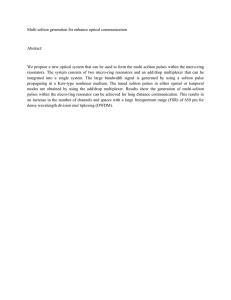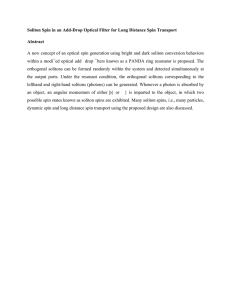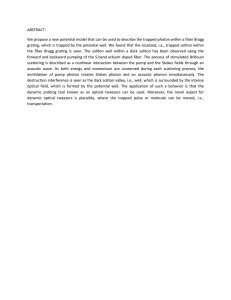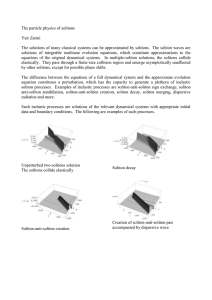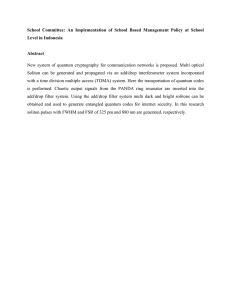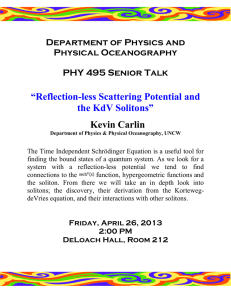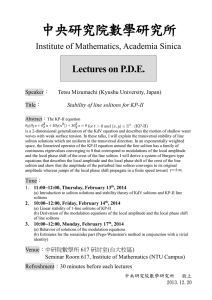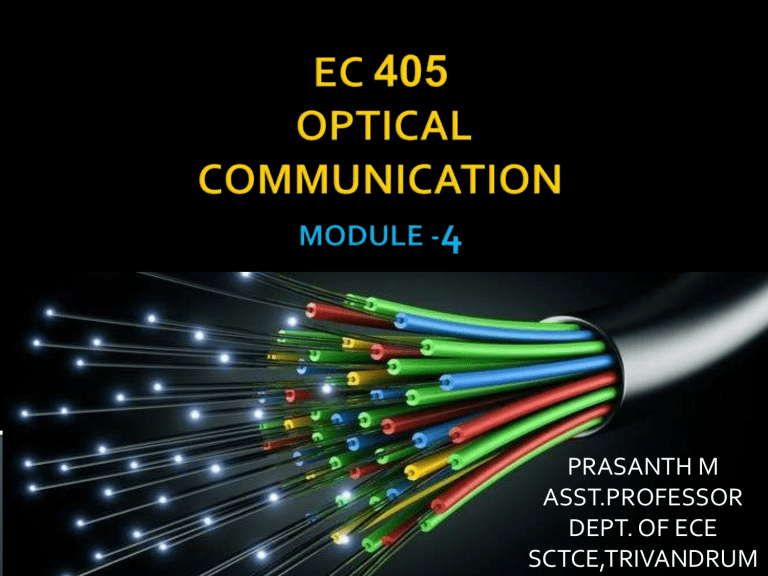
PRASANTH M ASST.PROFESSOR DEPT. OF ECE SCTCE,TRIVANDRUM Syllabus: Digital transmission systems, design of IMDD links- power and rise time budgets, coherent Systems, sensitivity of a coherent receiver, comparison with IMDD systems. Introduction to soliton transmission, soliton links using optical amplifiers, GH effect, soliton-soliton interaction, amplifier gain fluctuations, and design guide lines of soliton based links. IMDD SYSTEM Point-to-Point Links – IMDD system design Key system requirements needed to analyze optical fiber links: 1. The desired (or possible) transmission distance 2. The data rate or channel bandwidth 3. The desired bit-error rate (BER) LED or laser (a) Emission wavelength (b) Spectral line width (c) Output power (d) Effective radiating area (e) Emission pattern MMF or SMF (a) Core size (b) Core index profile (c) BW or dispersion (d) Attenuation (e) NA pin or APD (a) Responsivity (b) Operating λ (c) Speed (d) Sensitivity System considerations - Selecting the Fiber Bit rate and distance are the major factors Other factors to consider: attenuation and distance-bandwidth product, cost of the connectors, splicing etc. Then decide • Multimode or single mode • Step or graded index fiber System considerations - Selecting the Optical Source Emission wavelength depends on acceptable attenuation and dispersion Spectral line width depends on acceptable dispersion (LED wide, LASER narrow) Output power in to the fiber (LED low, LASER high) Stability, reliability and cost Driving circuit considerations System considerations - Selecting the detector • Type of detector – APD: High sensitivity but complex, high bias voltage (40V or more) and expensive – PIN: Simpler, thermally stable, low bias voltage (5V or less) and less expensive • Responsivity (that depends on the avalanche gain & quantum efficiency) • Operating wavelength and spectral selectivity • Speed (capacitance) and photosensitive area • Sensitivity (depends on noise and gain) Typical bit rates at different wavelengths Wavelength LED Systems LASER Systems. 800-900 nm 150 Mb/s.km (Typically Multimode Fiber) 2500 Mb/s.km 1300 nm (Lowest 1500 Mb/s.km dispersion) 25 Gb/s.km (InGaAsP Laser) 1550 nm (Lowest 1200 Mb/s.km Attenuation) Up to 500 Gb/s.km (Best demo) Design Considerations • Link Power Budget – There is enough power margin in the system to meet the given BER • Rise Time Budget – Each element of the link is fast enough to meet the given bit rate These two budgets give necessary conditions for satisfactory operation Link power budget • Optical power received at the photo detector depends on: – The amount of light coupled into the fiber – losses occurring within the fiber – Losses in connectors & splices – System Margin • Link power budget is derived from the sequential loss contributions of each element in the link. • Each of these losses are: • Pin and Pout are input and output powers of the loss element • In addition to the power losses, a margin is provided to accommodate ageing (6-10dB) Optical power-loss model PT Ps PR mlc nlsp f L System Margin PT : Total loss; Ps : Source power; PR : Rx sensitivity m connectors; n splices Rise-Time Budget Coherent systems • Unlike the direct detection coherent transmission technology uses all the wave aspects of light. The coherent detection process is sensitive to the amplitude, frequency and phase of an incoming optical signal. • The major advantages of the coherent systems are: - receiver sensitivity improvement of 5-20 dB, - excellent frequency selectivity, 1-10 GHz, - possibility of equalization at the intermediate frequency (IF) band Fig: Block diagram of coherent system MODULATION SCHEMES IN COHERENT DETECTION :ASK, FSK, PSK Derivation : HOMODYNE SYSTEM: The main advantage of HOMODYNE is that it is possible to transmit information by modulating the phase or frequency of the optical carrier. Disadvantages : a) the difference between Øs & ØLO should be a constant. But here it is not. b) matching of the transmitter and LO frequencies put stringent requirements on the optical sources. HETERODYNE SYSTEM Advantages: a) receiver design is simplified. b) Line width requirements are quite moderate when asynchronous demodulation scheme is used. IMDD system Vs Coherent system IMDD System Coherent system Intensity of optical signal is varied with Detection process is sensitive to amplitude, amplitude of the modulating signal. phase and frequency of the incoming optical signal No phase information is needed. So no local oscillator is required. Local oscillator is required. Detected electric current :𝐼𝑠 =2𝑅𝑃𝑠 𝑐𝑜𝑠𝜙 Detected electric current :𝐼𝑠 =2𝑅 𝑃𝑠 𝑃𝐿𝑂 𝑐𝑜𝑠𝜙 Simple complex Low sensitivity Receiver sensitivity improvement of 5-20 dB Low frequency selectivity Excellent frequency selectivity, 1-10 GHz, Low Power penalty High Power penalty Low Unamplified transmission distance High Unamplified transmission distance Low gain High gain Possibility of equalization at the intermediate frequency (IF) band Low hardware cost High cost Soliton propagation Time broadens due to GVD SPM overcomes the pulse broadening effect of GVD GH EFFECT • Advantages: 1.Dispersions are reduced 2.Pulse shape can be maintained 3.Transmission speed can be increased • Disadvantages: Proper power maintenance is a critical issue Ultra short pulses of picosecond pulse width Soliton features/advantages • A soliton has two distinctive features which are potentially important for the provision of high-speed optical fiber communications. 1. It propagates without changing shape 2. The shape is unaffected, that of a soliton, after a collision with another soliton. • The dispersion limitation and avoids inter symbol interference while the collision invariance. • Potentially provides for efficient wavelength division multiplexing. • Solitons are unaffected by polarisation mode dispersion. • Solitons are well matched with all optical processing techniques. • If the solitons are controlled properly they can be more robust than NRZ pulses • The particle nature of solitons can be employed for sliding-frequency guiding optical filters along the link. • The particle feature of solitons is also very useful to perform various all optical functions such as switching. Soliton Transmission System LASER cannot generate RZ pulse by its own. Uses optical modulator & NRZ-RZ converter driven by DFB LASER Here, Mach Zehnder modulator is used for modulating NRZ data at desired transmission rate (2.5-40Gbps) Instead of single NRZ stream, several multiplexed NRZ can be used before conversion to RZ At receiver, another RZ-NRZ converter is present and a demux separates the signals SOLITON- SOLITON INTERACTIONS Maximum data rate is determined by how close two adjacent pulse/bits can be packed. To determine how close two solitons can propagate without interacting one needs to solve nonlinear Schrödinger equation numerically with initial condition 𝑢 𝑧 = 0, 𝑡 = sech 𝑡 − ∆ + sech(𝑡 + ∆)𝑒 𝑗𝜃 where ∆ is their initial separation and θ is their relative phase. Note that ∆= 0 𝑔𝑖𝑣𝑒𝑠 𝑁 = 2 bound soliton while ∆= ∞ will correspond to two independent single solitons. Evolution of two co-propagating solitons with ∆= 3.5 is shown in figure . It can be seen that these collapse and separate with an oscillation period 𝑍0 𝑒 ∆ . This process is referred as “Brother Soliton”. If the relative phase “θ” between adjacent solitons is such that 𝜃 ≠ 0 then they experience repulsive force. Propagation over Length 𝐿𝑐 = 𝜋 ∆ 𝑒 results in collapse of two in2 phase soliton and distance ∆ apart at input. By choosing the soliton travel length 𝐿 𝑇 < 𝐿𝐶 soliton collapse can be avoided.
